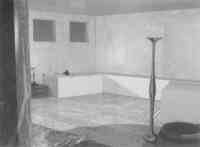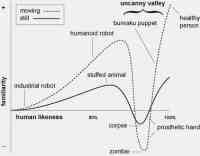
Figure 3: Triclinium from Miletus, Turkey 'lit by artificial lighting alone' (from Ellis 2000, plate 21)
3-D modelling forces the archaeologist to be unnecessarily precise about the location of often imprecise objects. 3-D software demands specific spatial co-ordinates for every point of every object. This introduces an impression of reality that is often at odds with the speculative nature of some models. The possibly deceptive nature of the process of modelling has been highlighted before (Eiteljorg 2000) and the need to model varying levels of certainty and provide metadata is important, but it is not just the shape and location of objects that can deceive the viewer. 'Any 3D program is about fakery: faking shapes, faking materials, everything, light included. The sooner we realize this, the better.' (Romero 2006). Although geometric realism, the realism of the shapes and sizes of objects, is important, realism in illumination, behaviour and relationships are also vital but more often ignored by modellers (Slater et al. 2002, 10). It is possible to provide visual cues as to how geometrically real structures and objects are; the issue of how real the illumination, behaviour and relationships between objects in a scene are can be more difficult to express via any medium but text. This is especially important in an environment such as the Pompeian house where the ability to produce images in different lighting conditions and its impact on room usage is an interesting avenue of research (Ellis 2000, 150).
Some 3-D modelling software such as Blender doesn't base its lighting on real world measurement, leaving the modeller to decide which level of lighting looks about right. In some ways this is an advantage to the archaeologist, as it removes any possibility of claiming a scientific basis for what is essentially an artistic judgement. Simon Ellis uses raytraced images of triclinia in his assessment of Roman dining conditions but claims 'the results are carefully calculated' (2000, 151). This is accompanied by an image supposedly showing artificial lighting in a triclinium in Turkey (Figure 3).

Figure 3: Triclinium from Miletus, Turkey 'lit by artificial lighting alone' (from Ellis 2000, plate 21)
As can be seen, this image shows a room suspiciously bright, considering it is supposed to be lit by oil lamps alone. Viewing the original (Figure 4), it can be seen that this image shows a more believably lit scene. Even now, the reader's impression of this image will depend on the processes applied to these images between the time it leaves my PC until it appears on their screen, in addition to their monitor settings when it arrives there. Obviously this image changed substantially in its apparent illumination realism between being sent by Simon Ellis to the publisher and when it appeared in print. Geometry rarely changes through reproduction, lighting nearly always does, even if only subtly.

Figure 4: Colour original of Figure 3 (© Simon Ellis, used with permission)
Attempts at reconstructing Pompeian domestic space that bring together elements from different sources have a long history. Both Mazois (1812) and Gell (1824) incorporated architecture, excavated artefacts and wall painting from different properties into the same scenes in their early 19th-century publications. This is a plausible method of reconstruction but necessitates assumptions to be made about the use of objects. We know the Pompeians had lararia in their homes and in the past it has been common to interpret all niches as evidence of a lararium. Allison (2004, 48-51) suggested that some niches may have had a more mundane role and could be used for storing items. If this is the case then the relationship between the architectural feature and its surroundings would be very different. The niche interpreted as a lararium would be surrounded by a decorative painting and possibly contain offerings to the household gods. A simple storage niche may contain an oil lamp or some cleaning equipment. The challenge to the modeller is to express this uncertainty visually. This is problematic with one image, easier with two.
Showing the amount of reality in the relationships between objects or architectural elements is difficult using only visual cues, especially where the form of the object itself also contains some element of hypothetical reconstruction. It is, however, especially important in Pompeii, where the tourist experience lacks so many different categories of object that it ensures a false impression of the ancient city. Le Corbusier took architectural inspiration from his visit to Pompeii and remarked 'Have respect for walls. The Pompeian did not cut up his wallspaces. He was devoted to wallspaces and loved light' (cited in Goalen 1995, 195). Le Corbusier's impressions, however, were gained on a visit to the site in modern times, without extensive roofing, and he didn't have the benefit of Allison's artefactual work indicating the amount of furniture sometimes obscuring the walls.
In forms of visualisation containing movement, behavioural realism also needs to be made explicit. How similarly a model moves or functions to its original counterpart affects its level of reality. This can be noticeable in mechanical mechanisms, sources of fire, humans and animals, water and plants among many others. Moving objects need an apparent weight to them, to be affected by gravity, to collide in a realistic manner and, when necessary, to get wet, burn or collapse. As with relational realism, behavioural realism is very difficult to quantify or make explicit using solely visual cues.
The common thread running through all types of realism is that the use of images to illustrate points made by an accompanying text enables much greater control to be placed on a viewer's assumptions than the presentation of an image alone as a 'reconstruction' of an ancient scene. 3-D modelling as an end in itself will mislead in some way owing to its lack of focus on explanation. Where illustration of explanation is the expressed function of modelling, the focus changes to the text and images are regarded as less authoritative.
In some cases, most notably that of incorporating humans into 3-D models, an increase in detail doesn't necessarily result in an increase in realism. In a paper published in 1970, Japanese roboticist Masahiro Mori identified a phenomenon he called 'the uncanny valley'. He was describing the effect caused by increasing the human likeness of robots, explaining that as likeness increases so does familiarity, until a certain point at which increasing likeness decreases familiarity until one starts to approach complete human simulation (Mori 1970) (Figure 5).

Figure 5: Graph of human likeness against familiarity showing the uncanny valley, also illustrating the effects of movement on it (after MacDorman 2005)
It seems human expectation plays some part in this effect (MacDorman 2005; Mori 1970); the more something appears to resemble a human at first glance, the more we expect it to behave in all respects as human. Mori uses the example of a well-developed prosthetic arm. Some are indistinguishable at first glance yet if we attempt to shake hands with a person fitted with one, we are surprised by the lack of warmth and realistic texture. This feeling shocks more than seeing, for example, someone equipped with a hook replacing a hand.
The uncanny valley is apparent in many archaeological visualisations when there is a need to populate certain scenes with supposedly authentic characters. The addition of human characters into computer-based models is desirable in a number of respects. Humans provide scale and also provide a vital way of creating recognition in viewers, although care must be taken. Piranesi's engravings show human characters that, if they were in proportion to the ruins around them, would be just 3 feet tall (Figure 1). One of the best ways of illustrating the uses of a particular space or feature is to show people actually interacting with it. Human characters then theoretically provide an emotional point of contact with an audience, increasing their ability to relate ancient situations with those from modern life. The issue of empathy with the characters in a visualisation is important.
Archaeological reconstructions tend to fall into the uncanny valley by assuming that increasing the human likeness of characters is always desirable. In a situation that must serve as a warning to archaeologists, even the film industry with its greater financial resources sometimes falls into the uncanny valley by attempting complete human simulation. The computer animation studio Pixar in The Incredibles placed the emphasis, according to director Brad Bird, on 'capturing the essence of reality rather than recreating reality' (Canemaker 2004) and this approach saw them create a successful product, whereas films such as Polar Express and Final Fantasy: The Spirits Within were poorly received by critics and audiences, partly due to the eerily non-human appearance of the main characters, despite more realistic animation techniques being used. It seems that the best chance a poorly resourced project has of avoiding this trap is to scale back its attempts to simulate ancient humanity, settling for an easier, more abstract approach based on the image that is intended to be conveyed. This may involve a large number of low polygon people to provide a sense of large-scale human activity and movement, or actual photos in the case of still images.
© Internet Archaeology/Author(s)
URL: http://intarch.ac.uk/journal/issue23/3/intreality.html
Last updated: Tues Feb 5 2008